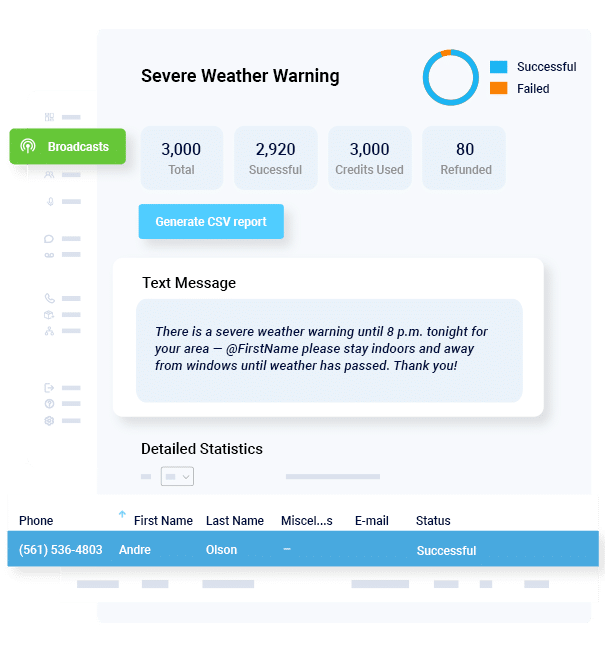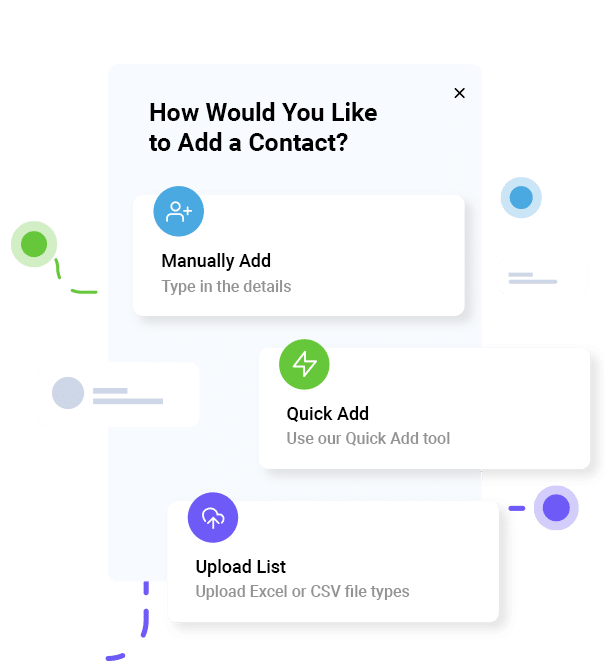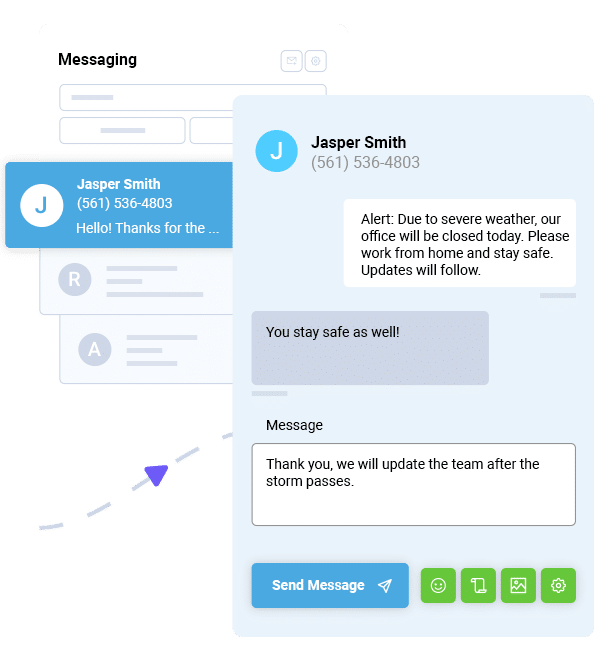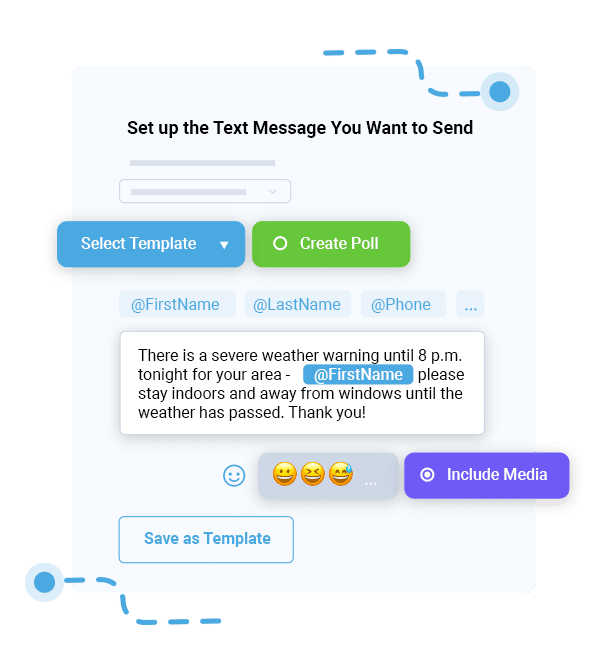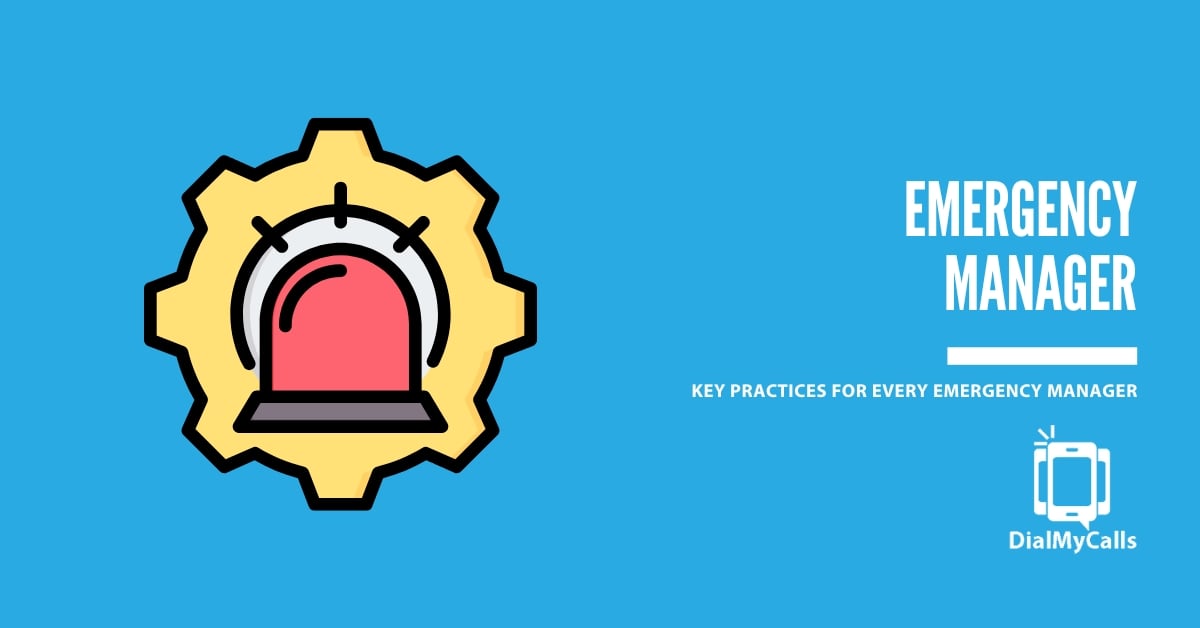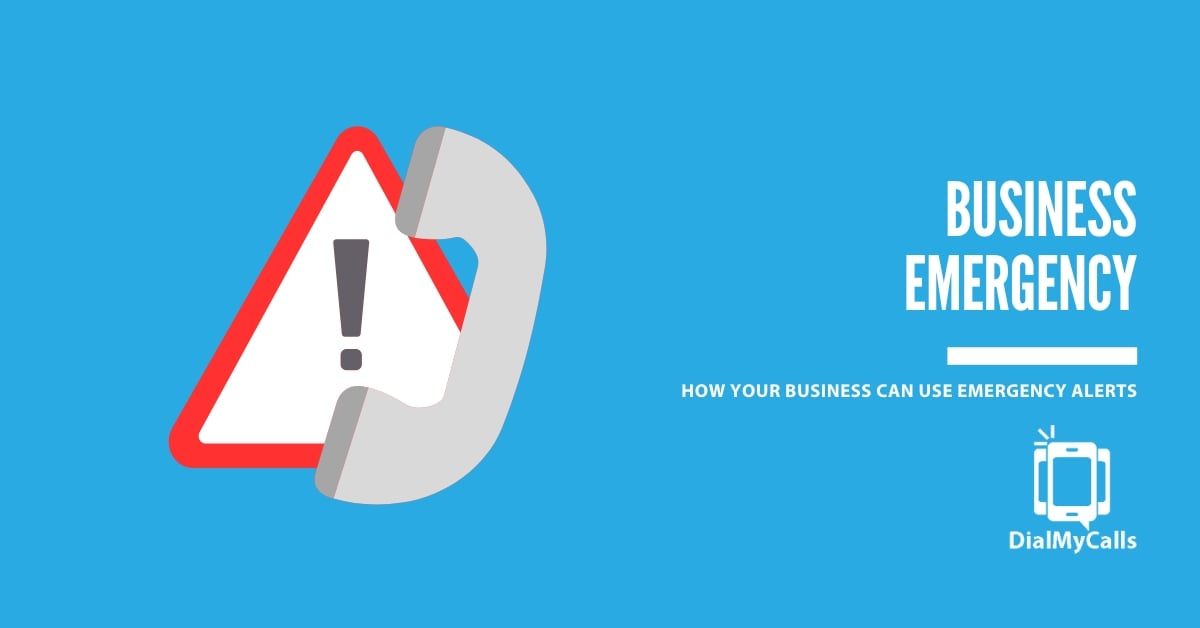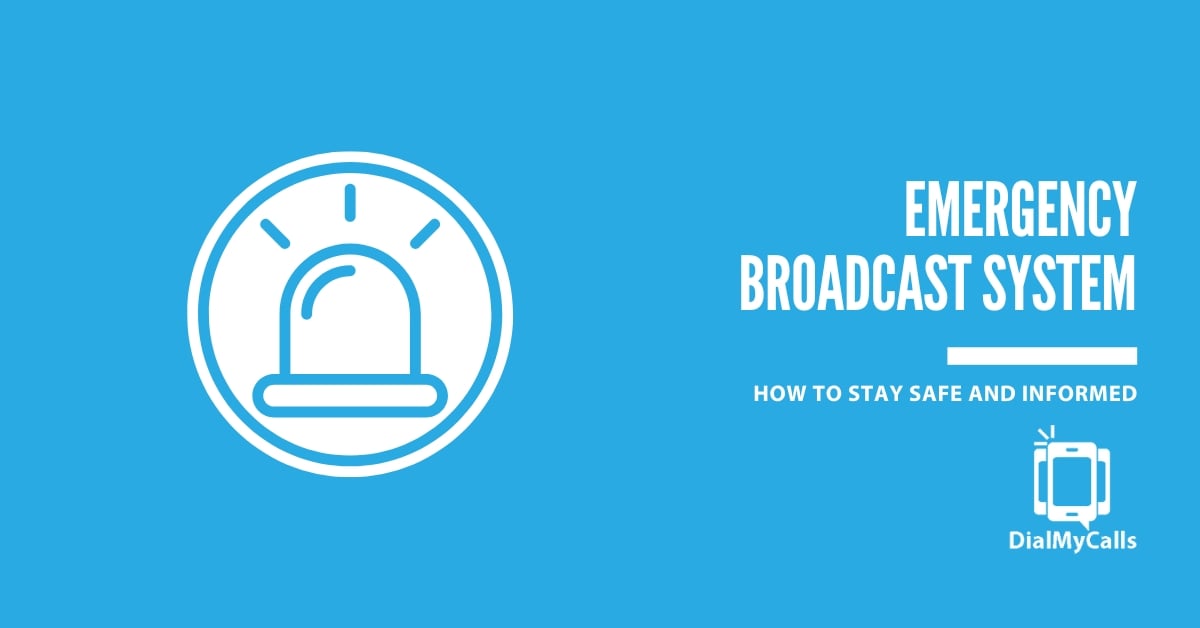Author

Ryan Betancur is an Emergency Management Planner at Hagerty Consulting and a proud US Army veteran. Drawing on years of experience, he specializes in healthcare and critical infrastructure emergency management, strategic planning, and business continuity. Ryan has been on the front lines managing COVID-19 responses in New Jersey and Illinois and supporting NYC's Migrant Crisis response. He holds a master's degree in Homeland Security and Emergency Management and multiple certifications in emergency preparedness.
Try Using DialMyCalls Right Now
Start For FreeRecent Posts
- 10 Proven Tips To Rapidly Grow Your SMS Subscriber List
- SMS Marketing Metrics: How to Measure and Improve Your Text Campaign’s Success
- What are SMS Carrier Fees and How to Lower Your Costs
- 8 Creative SMS Marketing Ideas to Boost Engagement This Summer
- 15 Ways to Use QR Codes For Event Promotion & Attendee Engagement
Categories
“I am a youth minister and have spent hours in the past calling students individually to remind them of an upcoming event or to get out an urgent announcement. With DialMyCalls.com, I cut that time down to about 1 minute. I also love how I can see exactly who answered live and how long they listened so I know if they heard the whole message. DialMyCalls.com is the best website I have stumbled upon all year! Thanks!”
Central Baptist Church
Try Using DialMyCalls Right Now
Start For FreeTop 3 Essential Workplace Emergency Procedures to Protect Employees and Ensure Safety
Posted by Ryan Betancur in Emergency Notification on November 18, 2024
Updated on January 22, 2025
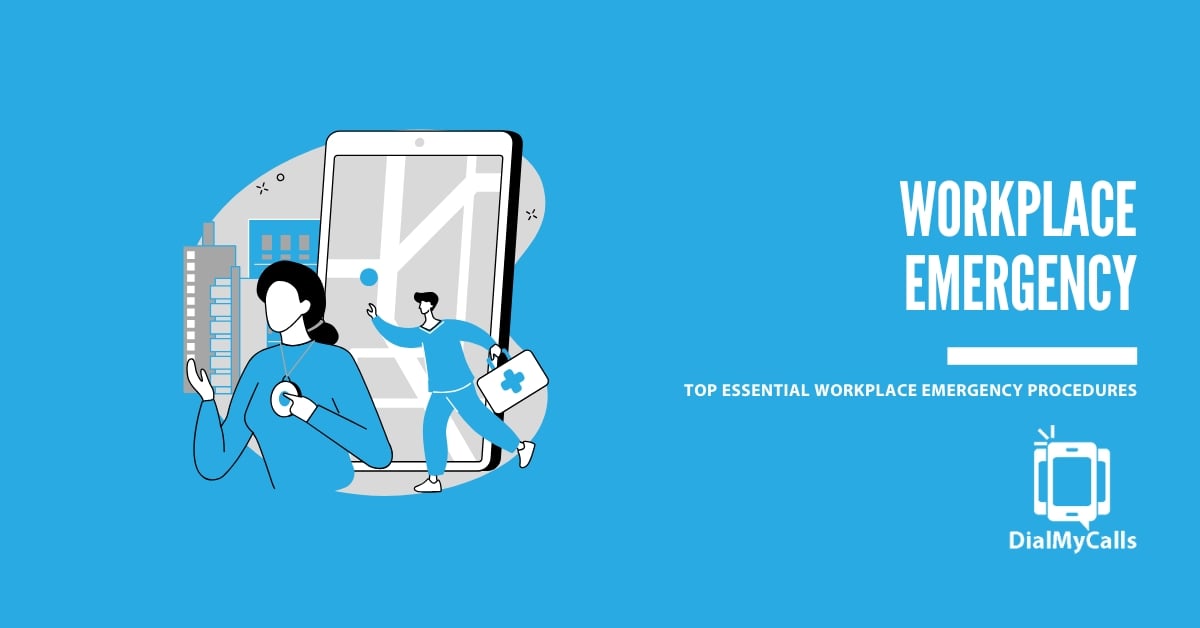
Imagine this: a fire breaks out in your office. Immediately, chaos erupts, and people scramble without direction. It’s a scenario you wouldn’t wish on anyone, yet it happens all too often when workplaces lack clear emergency procedures.
Emergencies don’t wait for you to be ready—they demand swift, decisive action. That’s why having a solid plan in place isn’t just a box to check for compliance. It’s an ethical responsibility to protect your employees and your business.
The Consequences of Inadequate Planning for Workplace Emergencies
No one expects to go through a workplace emergency. The “that just doesn’t happen here” mindset is all too prevalent. However, it takes just one tornado, flood, earthquake, or fire to show just how wrong-headed that stance is. And, unfortunately, inadequate planning can lead to some serious repercussions.
Don’t take our word for it, though. Below, you’ll find some pretty eye-opening statistics surrounding workplace emergencies of all types:
According to the US BLS, private industry employers reported 2.6 million nonfatal workplace injuries and illnesses in 2023 (down from 2022 thanks to COVID-19 prevention methods).
2022 saw almost 5,000 fatal workplace injuries in the US, which was up almost 6% from the previous year. The most common types of workplace emergencies include:
- Slips, trips, and falls
- Fires and explosions
- Chemical spills
- Machinery malfunction
- Dangerous gas releases
- Faulty equipment
- Severe weather
- Medical emergencies
- Workplace violence
- Civil disturbances (protests and strikes, for instance)
Inadequate planning can result in injuries, loss of life, legal liabilities, and disruptions that cripple operations. But with the right preparation, you can keep your employees safe and your business resilient, even in the face of a crisis.
Mass Texting, Made Easy
Send Bulk Text Message Campaigns in Seconds
Of course, your workplace is much more likely to experience certain types of emergencies. Understanding what those are and how to plan for them is important.
Here are the top three emergency procedures every workplace should adopt, and how clear communication, like that provided by DialMyCalls, can make all the difference when seconds count.
1. Fire Safety and Evacuation Plans
Fires can start and grow in seconds, turning your workplace into a hazardous environment. Your fire safety plan is your first line of defense. Here’s how to build and maintain a comprehensive approach to fire safety that will keep everyone calm and prepared when it matters most.
Risk Assessment: Know Your Vulnerabilities
Every business is unique, and so are its fire risks. Start by conducting a thorough fire risk assessment. Go through your facility with a fine-toothed comb:
- Identify fire hazards including flammable materials, overloaded electrical systems, or potentially combustible chemicals stored incorrectly.
- Assess high-risk areas like kitchens, manufacturing zones, or server rooms.
- Review employee workflows to pinpoint potential fire ignition sources, like hot machinery or open flames.
Use this assessment to create a customized fire safety strategy that addresses the specific risks of your workplace.
Fire Extinguishers and Safety Equipment
You might think having extinguishers on hand is enough, but accessibility and proper training are just as important. Place extinguishers and alarms where employees can easily reach them, and make sure they’re checked regularly. Don’t assume everyone knows how to use them. Offer hands-on training during fire drills.
Here’s what you need to know:
- Strategic Placement: Install extinguishers near exits, in high-risk areas, and along escape routes. Make sure they’re mounted at a height that’s easy to grab in an emergency.
- Regular Inspections: Schedule routine checks to ensure extinguishers are charged, unexpired, and free of damage.
- Employee Training: Extinguishers are only useful if employees know how to use them. Train your team on the PASS method (Pull, Aim, Squeeze, Sweep) during regular fire safety drills.
Fire Detection and Alarm Systems
Your fire detection system is your early warning system. Equip your workplace with:
- Smoke Detectors: These are essential in all enclosed areas, from office spaces to storage rooms. Choose hardwired detectors with battery backups for reliability.
- Heat Detectors: In environments with dust or fumes that might trigger false smoke alarms (like warehouses), heat detectors are more reliable.
- Alarm Systems: Alarms should be loud enough to be heard in every corner of your workplace, with visual indicators for any hearing-impaired employees.
Regularly test your fire detection systems to make sure they’re functioning properly and replace any faulty components immediately.
Evacuation Routes and Procedures
A good evacuation plan isn’t just about exiting the building; it’s about doing so quickly, safely, and without confusion. Here’s how to design one:
- Clear and Marked Routes: Map out primary and secondary evacuation routes. Post clear signage with arrows, and make sure paths are free of obstructions.
- Designated Assembly Areas: Assign a safe location outside the building where employees can gather. Make sure it’s far enough away from potential fire hazards and accessible for emergency responders.
- Evacuation Aids: For employees with mobility challenges, provide aids like evacuation chairs and train designated staff to use them.
Practice makes perfect—regular fire drills will help employees internalize the evacuation process.
Fire Wardens: Assign Roles and Responsibilities
In a fire emergency, leadership is essential. Appoint fire wardens to take charge during evacuations. Their responsibilities may include:
- Ensuring their designated area is cleared of people during an evacuation.
- Assisting employees with disabilities or injuries.
- Communicating with emergency responders to relay critical information.
- Conducting headcounts at assembly areas.
Train fire wardens regularly so they can act confidently when the time comes.
Instant Communication, Whenever You Need It
Send Real-Time SMS & Voice Call Alerts from Anywhere
Employee Education and Drills
Even the strongest fire safety plan is useless if employees don’t know about it. Make fire safety education a regular part of workplace training.
- Onboarding Sessions: Introduce new hires to the fire safety plan, including evacuation routes, fire extinguisher locations, and emergency contacts.
- Drills: Schedule fire drills at least twice a year. Include scenarios based on real challenges, like blocked exits or power outages, to ensure employees can adapt and remain calm.
- Feedback Loops: After each drill, gather feedback from employees and fire wardens to identify gaps and improve the plan.
Emergency Communication
During a fire, communication can make the difference between order and chaos. Establish a communication strategy so everyone stays informed:
- Mass Notifications: Use DialMyCalls to send instant alerts. Real-time updates can guide them to safe exits or inform them of obstacles.
- Intercom Announcements: If your workplace has a PA system, train designated staff to make clear, calm announcements during emergencies.
- Post-Evacuation Updates: After the immediate danger passes, communicate follow-up instructions, like whether employees should leave the premises or wait for further instructions.
When fire safety is taken seriously, it becomes a culture, not just a plan. Your employees will feel more confident knowing they’re prepared for emergencies, and your business will stand stronger in the face of potential crises.
2. Medical Emergency Protocols
Medical emergencies strike without warning, whether it’s a slip on a wet floor, a sudden heart attack, or an allergic reaction to lunch. How you respond in those critical moments can save lives and reduce harm. Here’s how to build and implement effective medical emergency protocols.
First Aid Procedures and Kits
A well-stocked first aid kit is a necessity. Go beyond band-aids and antiseptic, though. Include items like CPR masks and automated external defibrillators (AEDs). Identify employees willing to go through CPR and first aid training, and make their roles clear to everyone.
- Essential Contents: Beyond bandages and antiseptic wipes, include items like gauze pads, adhesive tape, scissors, tweezers, disposable gloves, burn ointments, and instant cold packs. For workplaces with specific risks, like kitchens or manufacturing facilities, add items like burn treatments or trauma dressings.
- Multiple Kits: Distribute those kits throughout the workplace. Think break rooms, high-traffic areas, and near known hazards.
- Regular Inspections: Assign someone to check all kits monthly and replace expired or depleted items.
CPR and AEDs: A Lifesaving Combination
For cardiac emergencies, immediate action can mean the difference between life and death.
- CPR Training: Provide employees with hands-on CPR training from certified professionals.
- Automated External Defibrillators (AEDs): Place AEDs in easily accessible locations, with clear signage. Train employees to use them.
Designated First Aiders
Not every employee needs to be a medical expert, but having designated first-aiders can improve response times and outcomes.
- Identification and Training: Choose volunteers or assign employees to become certified in first aid and CPR.
- Visible Identification: Provide first-aiders with badges or other identifiers so coworkers know who to approach in an emergency.
- Role Clarity: Ensure first-aiders know their responsibilities, whether that’s stabilizing an injured person or relaying critical details to emergency responders.
Emergency Contact Information
When medical help is needed, every second counts. Post emergency numbers where they’re visible and ensure all employees know how to summon aid.
- Post Emergency Numbers: Display local emergency numbers prominently in all common areas, including kitchens, break rooms, and near telephones.
- Internal Protocols: Create a list of internal contacts, such as HR or safety officers, who should be informed in the event of an emergency.
- Employee Contacts: Maintain up-to-date records of employee emergency contacts for notifying family members if needed.
Medical Protocols for Common Scenarios
Your workplace medical protocols should include a range of potential emergencies, each with clear, step-by-step instructions:
- Minor Injuries: For cuts, bruises, or minor burns, use the first aid kit to clean and dress the wound. If needed, provide transport to a clinic for further care.
- Allergic Reactions: Keep antihistamines and epinephrine auto-injectors (EpiPens) on hand if employees have disclosed severe allergies.
- Choking: Train staff in the Heimlich maneuver for choking emergencies, ensuring quick responses.
- Severe Injuries or Illnesses: For broken bones, unconsciousness, or suspected heart attacks, immediately call emergency services. Keep the injured person stable until professionals arrive.
Communication During a Medical Emergency
The right communication strategy ensures everyone knows their role and avoids confusion.
- Immediate Notifications: Empower employees to alert a designated person or team in the event of a medical emergency.
- Mass Alerts: Use DialMyCalls to send instant alerts to key personnel, like first-aiders or supervisors, while notifying other employees to stay clear of the area.
- Information for Responders: Prepare a summary of important details, like the injured person’s symptoms, actions already taken, and any known medical conditions, to hand off to emergency responders.
Special Considerations for Unique Workplaces
Different workplaces come with different risks, and your protocols need to reflect those.
- Office Environments: Focus on ergonomic injuries, stress-related conditions, and sudden illnesses like heart attacks or strokes.
- Industrial Settings: Emphasize protocols for chemical burns, crush injuries, and other workplace hazards.
- Public-Facing Businesses: Train employees to assist customers who may experience medical issues on your premises, like fainting or falls.
Post-Emergency Follow-Up
How you handle the aftermath of a medical emergency is just as important as the initial response.
- Incident Reports: Document the event thoroughly, including actions taken and the outcomes you experience. Use that data to help future planning.
- Employee Support: Offer counseling or other support services for employees involved in or affected by the emergency.
- Lessons Learned: Conduct a post-incident review with first aiders and other key personnel. Identify what went well and where improvements are needed.
Legal and Compliance Requirements
Staying compliant with workplace safety regulations isn’t optional—it’s central to protecting both your employees and your business.
- OSHA Standards: Familiarize yourself with Occupational Safety and Health Administration (OSHA) guidelines relevant to your industry, particularly those involving first aid and emergency response.
- State and Local Regulations: Some states require specific medical protocols or equipment, like AEDs in public spaces. Ensure your workplace meets these standards.
When medical emergencies occur, preparation saves lives. By investing in well-stocked first aid kits, employee training, and clear communication systems, you’re creating a workplace where safety isn’t just a priority—it’s a shared responsibility.
3. Active Shooter and Workplace Violence Response Plans
No one wants to think about it, but the rise in workplace violence makes preparation non-negotiable. A well-crafted response plan can save lives.
Run, Hide, Fight Strategy
The Department of Homeland Security’s “Run, Hide, Fight” framework is the cornerstone of active shooter response training. Each step provides a hierarchy of actions employees should take based on their circumstances during an incident.
Run: Evacuate If Safe to Do So
If it’s safe, encourage your people to evacuate. Include the following in your plan:
- Know Your Exits: Post clear maps showing evacuation routes and emergency exits throughout your facility.
- Leave Belongings Behind: Stress the importance of speed and safety over personal items.
- Assist Others: Employees should help others who may have mobility challenges but not at the risk of their own safety.
- Call 911: Once in a safe location, employees should call emergency services and provide details, like the location, number of shooters, type of weapons, etc.
Hide: If Escape Isn’t Possible
If evacuation is unsafe, hiding becomes the next best option:
- Secure the Area: Employees should lock doors, barricade entryways with furniture, and close blinds to limit visibility.
- Silence Devices: Phones and other electronics should be silenced to avoid drawing attention.
- Stay Low and Quiet: Hiding individuals should position themselves out of sight, preferably behind sturdy furniture, and remain as quiet as possible.
Fight: A Last Resort
When faced with imminent danger, employees should be prepared to defend themselves.
- Improvised Weapons: Encourage the use of objects like chairs, fire extinguishers, or heavy office supplies.
- Team Effort: Emphasize working together to overpower the attacker if it’s the only option left.
Workplace Violence Training
Prevention is just as critical. Offer training to help employees recognize the warning signs of potential violence, like sudden behavioral changes or verbal threats. Cultivate a culture where reporting concerns is encouraged and supported, rather than dismissed.
Reach Thousands, Instantly
Grow Your Business by Leveraging Mass Texting
Effective preparation starts long before an incident occurs. Comprehensive training equips employees with the knowledge and confidence to act decisively.
Active Shooter Drills: Conduct regular drills to simulate scenarios and familiarize employees with the “Run, Hide, Fight” approach.
Recognizing Warning Signs: Train your employees to spot early indicators of potential violence, including:
- Drastic changes in behavior or mood.
- Aggressive or threatening comments.
- Signs of extreme stress, personal crises, or grievances.
Creating a Reporting Culture:
Encourage your people to report worrying behaviors without fear of reprisal. Establish an anonymous reporting system for added comfort.
Emergency Communication Systems
Rapid communication is essential during an active shooter situation. Employees need real-time updates so they can make accurate decisions.
- Mass Notification Tools: Use DialMyCalls to send instant alerts via text, voice call, or email. These alerts can notify employees of the situation, provide escape instructions, or direct them to safety.
- Silent Alerts: Use panic buttons or mobile apps so employees can discreetly notify security or law enforcement.
- Intercom Announcements: Train key people to make clear, calm announcements, providing critical information without creating panic.
Coordination with Law Enforcement
Active shooter incidents require immediate and coordinated responses from law enforcement. Building a relationship with local authorities before an emergency occurs is critical.
- Collaborative Training: Invite law enforcement to participate in your active shooter drills. Their expertise can enhance your plan’s effectiveness.
- Facility Tours: Give local police a tour of your workplace so they’re familiar with its layout.
- Information Sharing: Provide law enforcement with detailed information during an incident, including building maps, locations of safe rooms, and the number of employees on-site.
Post-Incident Support and Recovery
Surviving an active shooter incident is only the beginning. Employees will need significant support to heal and regain a sense of normalcy.
- Trauma Counseling: Provide employees with access to professionals who specialize in trauma and crisis recovery.
- Team Debriefs: Organize group discussions to address lingering fears, share experiences, and reinforce a sense of community.
- Policy Review: Conduct a detailed analysis of the incident to identify what worked, what didn’t, and how your plan can be improved.
Legal and Compliance Considerations
Employers have a legal and ethical responsibility to protect their workforce from foreseeable risks.
- OSHA Guidelines: While OSHA doesn’t have specific active shooter requirements, general workplace safety standards still apply. Employers must provide a safe working environment.
- State Laws: Some states mandate specific training or emergency response plans for businesses. Ensure your protocols align with local regulations.
- Liability Mitigation: Document all training sessions, drills, and safety investments to demonstrate due diligence in case of litigation.
An active shooter incident may be one of the most terrifying emergencies your workplace could face, but preparation can significantly reduce risks and improve outcomes. By training employees, securing your facility, and building a culture centered around awareness and communication, you create an environment where safety takes priority. Above all, remember that the point of every protocol, drill, and safety measure is to protect lives—and that’s a responsibility no business should take lightly.
The Role of Communication During Workplace Emergencies
Emergencies thrive on confusion, but communication cuts through it. Here’s how to make it a cornerstone of your emergency strategy:
Proactive Communication Before an Emergency
From onboarding materials to well-placed signage and regular drills, your employees should always know what to do when an emergency hits. Communicating these plans in advance reduces uncertainty and hesitation.
Real-Time Communication During Emergencies
The moment an emergency unfolds, you need a way to reach everyone fast. This is where tools like DialMyCalls shine. Whether it’s a text, email, or automated voice message, a mass notification system ensures every employee gets clear instructions in seconds.
Post-Emergency Communication
When the dust settles, your team needs guidance for recovery. Follow up with updates on safety measures, offer counseling if needed, and communicate any adjustments to procedures. Employees should feel supported long after the immediate threat is over.
How DialMyCalls Enhances Emergency Communication
During a crisis, every second matters. DialMyCalls offers a mass notification platform designed for those critical moments. With a single message, you can alert your entire team across multiple channels—SMS, voice calls, and email—ensuring no one is left uninformed.
DialMyCalls also allows for pre-recorded alerts, so you’re not scrambling to craft a message in the heat of the moment. Whether it’s a fire, medical emergency, or active shooter situation, this tool ensures your communication is timely, clear, and effective.
Note that you can find detailed guides for many other types of emergencies, including earthquakes, floods, hurricanes, and more with OSHA.
Conclusion
When it comes to workplace emergencies, the best defense is a good plan. Fire safety protocols, medical response procedures, and active shooter plans protect not just your employees, but the future of your business. And none of these plans work without clear, effective communication.
By implementing these top three procedures and leveraging tools like DialMyCalls, you’ll create a safer, more resilient workplace. Don’t wait for the unthinkable to happen—prepare now, because the safety of your team is always worth it. Maintain communication during a workplace emergency by signing up for a free DialMyCalls account today!
Stay Connected with Mass Notifications
Create & Send a Broadcast to Thousands in Seconds
